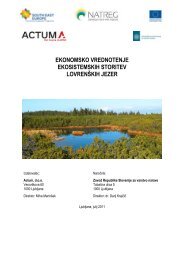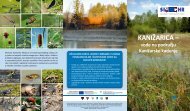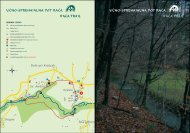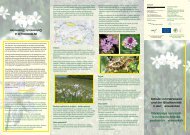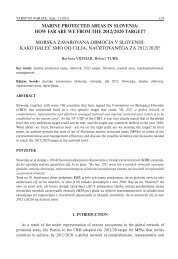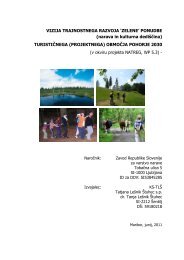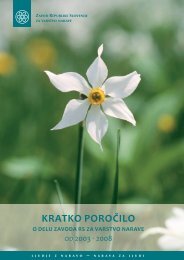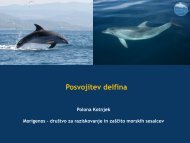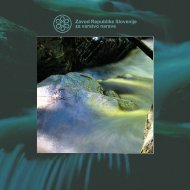Monitoring MPA visitor uses handbook
Monitoring MPA visitor uses handbook
Monitoring MPA visitor uses handbook
- No tags were found...
Create successful ePaper yourself
Turn your PDF publications into a flip-book with our unique Google optimized e-Paper software.
5.15.2 Relevance of the Economicbenefits of <strong>visitor</strong> use indicatorThis indicator requires the development of a socio-economicstudy and aims to answer two key questions :• What are the economic benefits of <strong>visitor</strong> use (in termsof employment and added value) of the <strong>MPA</strong> for economicactivity in neighbouring areas.• To what extent can <strong>visitor</strong> use generate revenues tofund the cost of <strong>MPA</strong> protection?The scope of monitoring this indicator extends greatlybeyond the boundaries of the <strong>MPA</strong>. In the same wayas the issue of conservation, inclusion of this economicdimension is vital for the definition of sustainable tourismin the <strong>MPA</strong>.Multidisciplinary indicator implementation inLes Calanques National Park (France).The Liteau FHUVEL programme (Fréquentation Humaineet Vulnérabilité Écologique du Littoral - Visitor use andEnvironmental vulnerability of the Coast) for the 2009-2012 period primarily aims to develop a cross-disciplinarymethodology to assess the vulnerability of the remarkablecoastal ecosystems (coralline, Posidonia grass bedsand Trichoptera) and to identify the factors responsiblefor that vulnerability to prioritise conservation or evenrestoration needs. By crossing indicators, FHUVELinterlinks biological data with <strong>visitor</strong> and use data toidentify sociological and ecological tolerance thresholdsand move towards carrying capacity indicators.The workshop sites are expected to provide concretecontributions to help develop management and decisiontools for use in Les Calanques National Park, takingaccount of <strong>uses</strong>, social representations and the necessaryprotection of nature.Coralline formation, Les Calanques National Park (France).© Credit: Olivier BianchimaniThe benefit of an initial evaluation of <strong>visitor</strong>use and biocenoses to assess the impactof a new development: the example of theTables diving site in the Posidonia grassbeds of Cap d’Agde marine protected area(France).The Tables site is a small, rocky submarine area onlya few hundred metres from the cliffs of Cap d’Agde. Itconsists of a set of volcanic tuff slabs with numerousfaults, caves and overhangs that are home to extremelydiverse fauna and flora greatly sought-after by divers.At the Tables site, the problem of <strong>visitor</strong> use (diving andmooring) and its impact was addressed relatively earlyon. Studies were initiated in 1999 (Musard, 1999; Payrot,2001) and evidenced the significant pressure generatedby deep-sea diving on certain coastal sites of Agdeincluding the Tables, with numbers in summer estimatedat 8,500 dives and some 850 mooring boats. Surveyswere also conducted with local diving clubs and theopinions obtained were unanimous about the problem of"overcrowding" in the Tables site. Plans were thereforemade in 2005 to install seven Harmony-type ecologicalmooring buoys at the site, following an initial analysis tobe able to subsequently monitor and measure the effectsof the new facilities on marine biocenosis restoration. Thewhite gorgonian seafan Eunicella singularis was selectedas the indicator species owing to its representativenessin the study zone and because it is a sessile organismwhich, by definition, cannot flea pressure.The study was conducted in 2010 and 2012 by theAssociation ADENA. After only five years, the restorationof the white seafan population was already taking placeat the Tables site. Analyses showed a clear growth in thepopulation between 2005 and 2010 which continued until2012, together with development in the coverage of rockyareas. The high densities of young gorgonians reflectthe area's potential for development and regeneration.With an increase in densities of large gorgonians too, theresults concerning the natural restoration of white seafanare extremely positive, both in terms of the conservationbenefits of this kind of mooring and the willingness ofdiving clubs, as stakeholders of the "Posidonies duCap d’Agde" Natura 2000 site, to use the facilities forsustainable protection.Reference : Blouet S., Chéré E., Dupuy de la Grandrive R.,Foulquié M. 2010. Restauration naturelle des populationsde gorgones blanches Eunicella singularis (Esper, 1794)après installation d’ancrages écologiques Harmony, sur lesite de plongée des Tables. "Posidonies du Cap d’Agde"Natura 2000 Site FR-9101414. ADENA publ. Fr. : 58PP.Foulquié M., Blouet S., Chéré E., Dupuy de la GrandriveR., Fabre E., Dalias N., 2012. Restauration naturelle despopulations de gorgones blanches Eunicella singularis(Esper, 1794) après installation d’ancrages écologiquesHarmony, sur le site de plongée des Tables. "Posidoniesdu Cap d’Agde" Natura 2000 Site FR-9101414. ADENA,SEANEO publ. Fr. : 91PP TABLE OF CONTENTS 40 COLLECTION VISITOR USE OBSERVATION AND MONITORING IN MEDITERRANEAN MARINE PROTECTED AREAS



